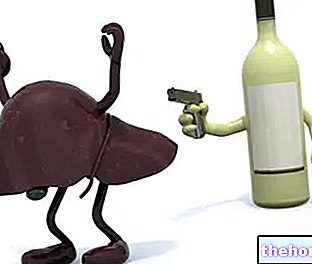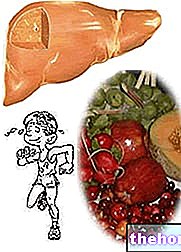More than a real disease, cholestasis is a condition associated with various pathologies, accumulated by the severe impairment of the flow of bile towards the duodenum. In intrahepatic cholestasis the biliary obstruction is internal to the liver, while in extrahepatic cholestasis the block is located outside the organ.
Liver, Bile and Gallbladder
Bile is a concentrate of organic compounds (both exogenous and endogenous), produced by the liver in quantities of about 6 dl per day.

The bile plays an essential role for the adequate digestion of the lipids introduced with the diet; it also buffers the acidity of the gastric chyme, stimulates intestinal peristalsis and exerts an antiseptic action against the bacterial flora, inhibiting putrefactive phenomena. Through the bile the products deriving from the degradation of hemoglobin (bilirubin), toxic substances of pharmacological origin and others of an endogenous nature (thyroid hormones, estrogens, cholesterol, etc.) are also removed from the organism.
Causes
Tumors of the bile ducts
Cyst
Stenosis of the bile ducts
Stones in the common hepatic duct
Pancreatitis
Tumors of the pancreas or pseudocysts
Tumor masses in adjacent organs
Primary sclerosing cholangitis
Alcohol abuse liver disease
Amyloidosis
Bacterial abscess in the liver
Lymphoma, primary or secondary tumors of the liver
Pregnancy (obstetric cholestasis)
Primary biliary cirrhosis
Primary sclerosing cholangitis
Sarcoidosis
Sepsis
Tuberculosis
Acute viral hepatitis
Sjögren's syndrome
Numerous drugs, such as chlorpromazine, prochlorperazine, gold salts, nitrofurantoin, anabolic steroids, sulindac, cimetidine, erythromycin and estrogen (including oral contraceptives), can cause cholestasis and produce liver damage.
Symptoms
Clay-colored or whitish stools dark urine; digestive difficulties with steatorrhea (greasy stools); skin itching; nausea or vomiting; pain in the liver (under the last ribs of the right side); yellowish discoloration of the skin or whites of the eyes (jaundice). Symptoms such as abdominal pain, lack of appetite, splenomegaly (enlargement of the spleen), ascites (fluid accumulation in the abdominal cavity), fever, spider Naevi (capillary dilations that converge at a central point, taking on the typical spider appearance), and rapid weight loss can be a sign of severe liver disease.
Biliary colic, due to the presence of stones in the biliary tract, is characterized by a very violent pain that arises in the upper part of the abdomen, in the center or more frequently to the right under the ribs; subsequently the pain extends posteriorly until it reaches the lower tip of the shoulder blade.
Diagnosis
In the presence of cholestasis, blood tests may show high levels of total bilirubin, alkaline phosphatase, gamma-glutamyl transpeptidase (Gamma-GT), and bile acids.
Instrumental tests, such as CT scan, ultrasound and abdominal magnetic resonance, are necessary to investigate the causes of origin of cholestasis. To highlight the state of health of the bile ducts, an endoscopic retrograde cholangiopancreatography can be performed (thanks to a tube sent down orally until it reaches the extrahepatic biliary tract; if necessary, this probe allows for therapeutic maneuvers such as the removal of stones or the restoration of the patency of the occluded canals).
Care and treatment
The therapeutic intervention depends on the causes that have produced the cholestasis. The stones can be removed with a minimally invasive surgery or with interventional diagnostic techniques. Stents can be applied to the narrowing points (stenosis) of the bile ducts, a bit like happens in angioplasty. Cholestyramine, taken orally, can help in resolving the annoying itching typically associated with cholestasis (alternatively topical creams based on corticosteroids, or oral ursodeoxycholic acid can be used for short periods). During the treatment of cholestasis it is important to avoid the intake of any substances harmful to the liver, such as alcohol, fried fats and some medicines.
Continue: Drugs for the Treatment of Cholestasis "




























